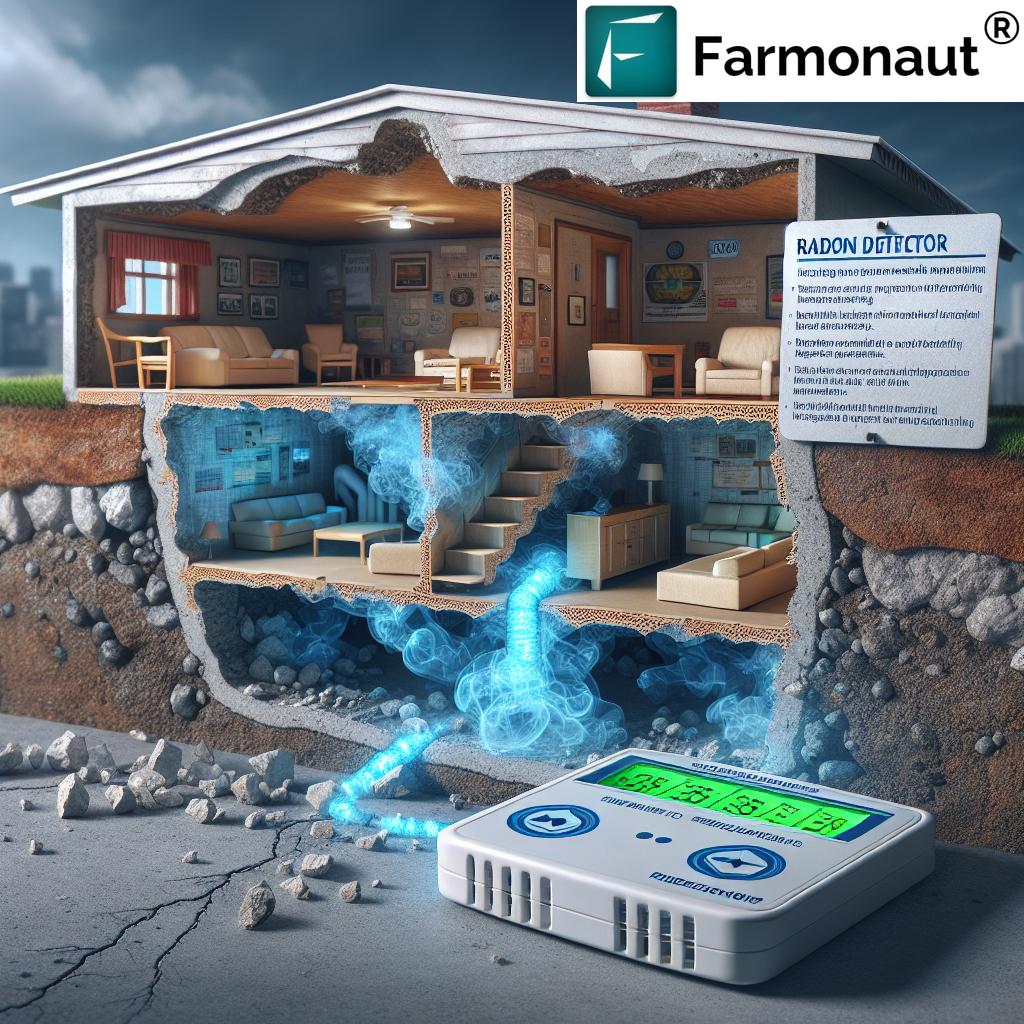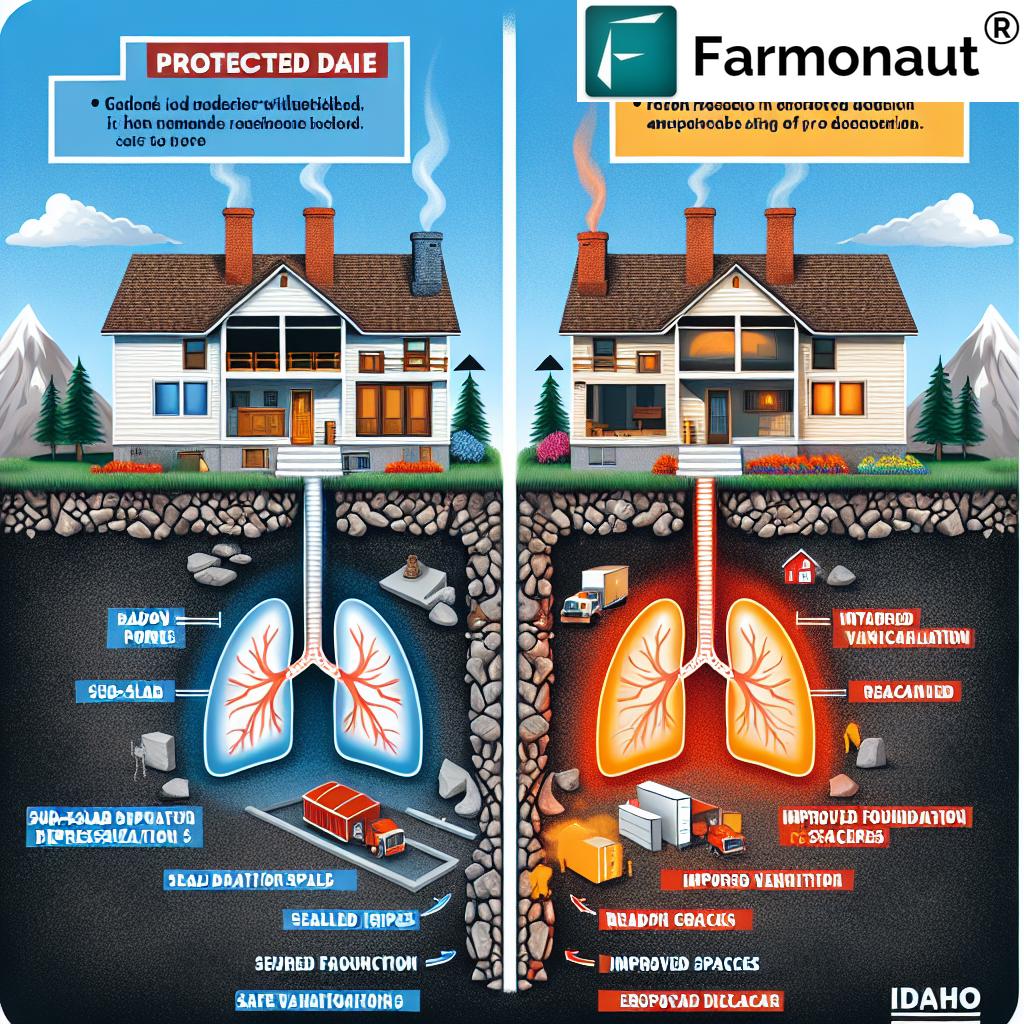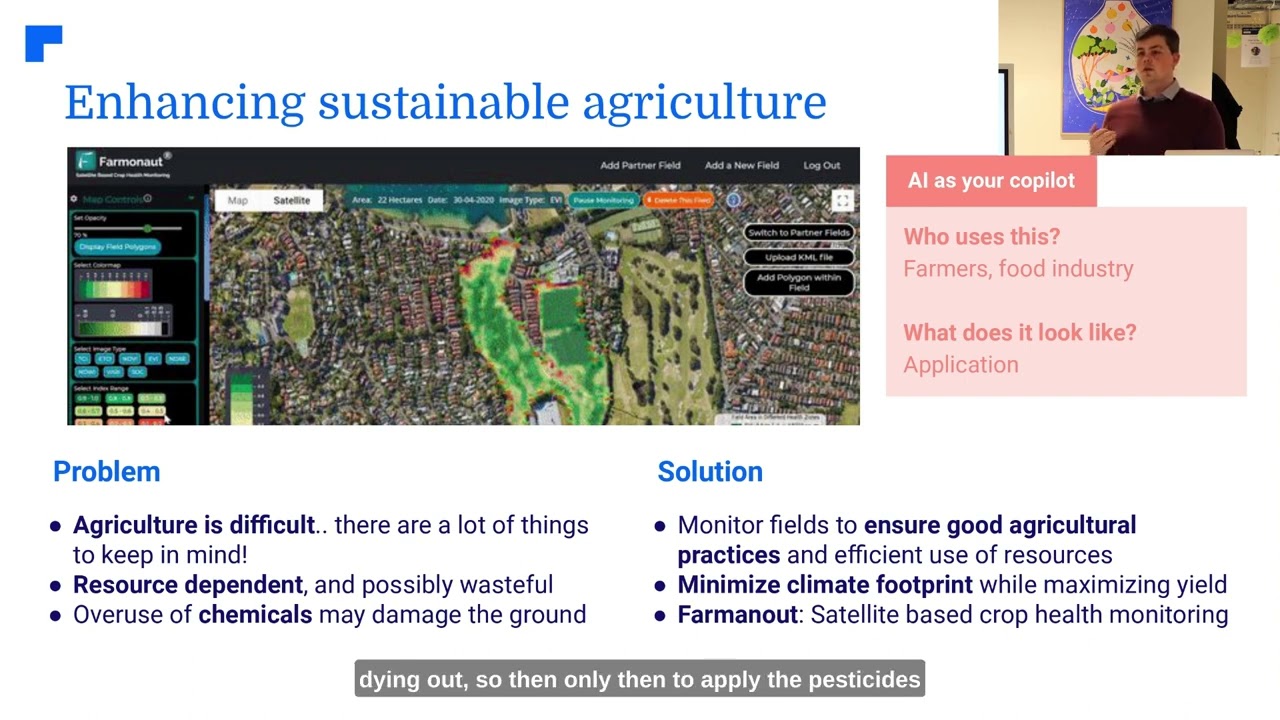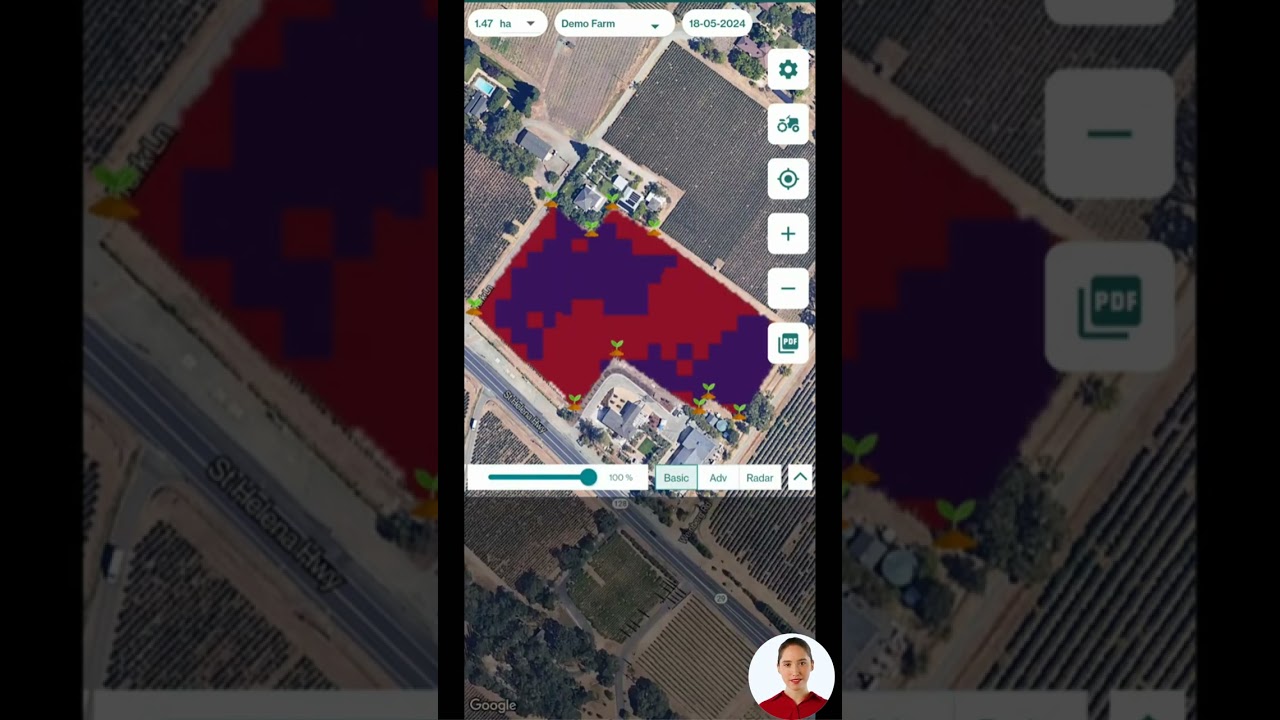Radon Risks in Idaho Homes: Essential Testing and Mitigation Strategies for Lung Cancer Prevention

“40% of Idaho homes show elevated radon levels, making it the eighth-highest state for radon exposure.”
In the serene landscapes of Idaho, a silent threat lurks beneath the surface, posing a significant risk to the health and well-being of its residents. We’re talking about radon, an invisible, odorless, and radioactive gas that has become a pressing concern for homeowners across the Gem State. As we delve into this critical issue, we’ll explore the dangers of radon exposure, its prevalence in Idaho homes, and most importantly, the essential steps you can take to protect yourself and your loved ones.
Understanding Radon: The Hidden Danger in Idaho Homes
Radon is a naturally occurring radioactive gas that forms from the decay of uranium in soil and rock. In Idaho, where uranium-rich deposits are common, the risk of radon infiltration into homes is particularly high. This colorless and odorless gas can seep into buildings through cracks in foundations, walls, and floors, accumulating in enclosed spaces and posing a severe health hazard to occupants.
The Environmental Protection Agency (EPA) has identified radon as the second leading cause of lung cancer in the United States, contributing to approximately 21,000 deaths annually. This statistic is particularly alarming for Idaho residents, given the state’s high radon levels.
The Idaho Radon Predicament
According to experts from the Idaho Department of Health and Welfare (IDHW), approximately 40% of homes in Idaho have elevated radon levels that warrant mitigation. This startling figure places Idaho as the eighth-highest state in the nation for radon exposure, underscoring the urgency of addressing this issue.
Joseph Danes, a seasoned radon tester and mitigator, emphasizes the critical need for increased public awareness regarding the dangers of radon exposure. He notes that many Idaho residents are unaware of the potential risks lurking in their homes, highlighting the importance of education and proactive testing.
How Radon Enters Idaho Homes
- Foundation cracks
- Gaps in flooring
- Porous building materials
- Well water (in some cases)
Radon’s unique chemical properties allow it to permeate even seemingly solid barriers. Danes points out that the gas can penetrate through three-foot-thick concrete slabs, illustrating the challenge of completely sealing off a home from radon infiltration.
Measuring Radon Levels: Understanding the Risk
Radon levels are measured in picocuries per liter (pCi/L). The EPA recommends taking action to reduce radon levels in homes with readings of 4 pCi/L or higher. To put this into perspective, exposure to 4 pCi/L of radon is equivalent to the radiation risk of smoking eight cigarettes a day.
Here’s a breakdown of radon risk levels and recommended actions:
| Radon Level (pCi/L) | Risk Category | Estimated Annual Lung Cancer Risk | Recommended Action |
|---|---|---|---|
| <2 pCi/L | Low risk | 2 in 1,000 | No action needed |
| 2-4 pCi/L | Moderate risk | 4 in 1,000 | Consider mitigation |
| 4-8 pCi/L | High risk | 7 in 1,000 | Strongly recommend mitigation |
| >8 pCi/L | Very high risk | 14 in 1,000 | Take immediate action to reduce levels |
The Importance of Regular Radon Testing
Given the invisible nature of radon and its potential health impacts, regular testing is crucial for Idaho homeowners. The EPA advises testing homes for radon at least every two years. This frequency allows for the detection of any changes in radon levels that may occur due to shifting soil conditions, home renovations, or other factors that could affect radon infiltration.
Digital Radon Detectors: A Homeowner’s Best Friend
Advancements in technology have made radon testing more accessible than ever. Digital radon detectors, available for around $100 from hardware stores or online retailers, offer an efficient way for homeowners to monitor their radon levels continuously. These devices provide real-time readings and long-term averages, allowing for a comprehensive understanding of radon exposure in the home.
Danes recommends leaving these detectors in place for extended periods to ensure accurate readings. This approach accounts for seasonal variations in radon levels, which can be significant in Idaho’s climate.
Seasonal Variations in Radon Levels
It’s important to note that radon levels can fluctuate throughout the year, with winter months typically showing higher concentrations. This seasonal variation is due to several factors:
- Frozen ground preventing radon from dispersing into the atmosphere
- Increased home heating leading to a stack effect, drawing radon from the soil
- Reduced ventilation in homes during colder months
Understanding these seasonal patterns underscores the importance of year-round monitoring and the potential need for adjustments to mitigation strategies based on seasonal fluctuations.
Radon Mitigation Strategies for Idaho Homes
When elevated radon levels are detected, mitigation becomes essential. There are several effective strategies for reducing radon concentrations in homes:
- Sub-slab depressurization: This method involves installing a pipe and fan system to draw radon from beneath the foundation and vent it outside.
- Sealing entry points: Identifying and sealing cracks and gaps in the foundation can help reduce radon infiltration.
- Improving ventilation: Increasing airflow in basements and crawl spaces can help dilute radon concentrations.
- Installing a radon sump: Similar to a water sump, this system collects and vents radon before it enters the home.
It’s crucial to work with certified radon mitigation professionals when implementing these strategies to ensure effectiveness and compliance with local regulations.
The Correlation Between Radon Exposure and Smoking
While radon poses a risk to all individuals, smokers face a significantly higher danger when exposed to elevated radon levels. The synergistic effect between radon exposure and smoking dramatically increases the risk of lung cancer. For instance, a smoker exposed to 4 pCi/L of radon faces about 62 times the risk of lung cancer compared to a non-smoker exposed to the same level.
This correlation emphasizes the importance of radon mitigation for all homeowners but underscores the critical nature of testing and mitigation for households with smokers or former smokers.
Explore Farmonaut’s API for advanced data integration
Idaho’s Radon Awareness Initiatives
Recognizing the severity of the radon issue, the Idaho Department of Health and Welfare has launched several initiatives to promote awareness and encourage testing:
- Free radon test kits distributed to the public
- Educational programs for homeowners and real estate professionals
- Youth art contests centered around radon awareness
- Partnerships with local health districts to expand outreach
These efforts aim to increase public knowledge about radon risks and empower Idaho residents to take proactive steps in protecting their health.
“Radon, an invisible and odorless gas, is the second leading cause of lung cancer after smoking.”
The Lack of Regulatory Mandates in Idaho
Despite the significant health risks associated with radon exposure, Idaho currently lacks regulations mandating radon testing in residential or commercial buildings. This regulatory gap places the responsibility for testing and mitigation squarely on homeowners and property managers.
While some states have implemented laws requiring radon testing during real estate transactions or in schools, Idaho has yet to adopt such measures. This situation highlights the importance of individual awareness and action in addressing radon risks.
Steps for Idaho Homeowners to Address Radon Risks
Given the high prevalence of radon in Idaho homes, we recommend the following steps for homeowners:
- Test your home: Conduct an initial short-term test, followed by a long-term test if levels are elevated.
- Understand your results: Compare your test results to the EPA’s action level of 4 pCi/L.
- Plan for mitigation: If levels are high, consult with a certified radon mitigation professional.
- Implement mitigation strategies: Follow through with recommended mitigation techniques.
- Retest after mitigation: Ensure that radon levels have been successfully reduced.
- Continue monitoring: Use a digital radon detector for ongoing awareness of radon levels in your home.
Check out Farmonaut’s API Developer Docs for integration guidance
The Role of Indoor Air Quality Testing
While radon testing is crucial, it’s part of a broader approach to ensuring healthy indoor air quality. Comprehensive indoor air quality testing can identify other potential pollutants that may interact with or exacerbate the effects of radon exposure. These may include:
- Volatile Organic Compounds (VOCs)
- Mold spores
- Particulate matter
- Carbon monoxide
By addressing overall indoor air quality, homeowners can create a healthier living environment that minimizes multiple health risks, including those associated with radon exposure.

Lung Cancer Prevention: Beyond Radon Mitigation
While addressing radon exposure is a critical step in lung cancer prevention, it’s important to consider a holistic approach to respiratory health. In addition to radon mitigation, consider these strategies:
- Quit smoking and avoid secondhand smoke
- Maintain a healthy diet rich in antioxidants
- Exercise regularly to improve lung function
- Limit exposure to other environmental pollutants
- Get regular health check-ups and screenings
By combining radon mitigation with these healthy lifestyle choices, Idaho residents can significantly reduce their risk of lung cancer and improve overall health.
The Future of Radon Awareness and Mitigation in Idaho
As awareness of radon risks grows, we anticipate several developments in Idaho’s approach to this health hazard:
- Increased public education campaigns
- Potential legislative action mandating testing in certain situations
- Advancements in radon detection and mitigation technologies
- Greater integration of radon considerations in building codes and practices
These changes could significantly impact how Idaho addresses its radon challenge, potentially leading to reduced exposure rates and improved public health outcomes.
Conclusion: Taking Action Against Radon in Idaho
The prevalence of radon in Idaho homes presents a significant but manageable health risk. By understanding the dangers of radon exposure, implementing regular testing protocols, and taking appropriate mitigation steps, Idaho residents can protect themselves and their families from this invisible threat.
Remember, radon awareness is not just about individual homes—it’s about creating healthier communities across Idaho. By sharing information, encouraging testing, and supporting mitigation efforts, we can collectively reduce the impact of radon on public health in the Gem State.
Take the first step today: test your home for radon and encourage your neighbors to do the same. Together, we can make Idaho homes safer and healthier for everyone.
FAQ Section
Q: How often should I test my Idaho home for radon?
A: The EPA recommends testing your home for radon at least every two years. However, if you’ve implemented mitigation measures or made significant changes to your home’s structure, more frequent testing may be advisable.
Q: Can I test for radon myself, or do I need a professional?
A: You can perform radon testing yourself using readily available test kits or digital radon detectors. However, for the most accurate results, especially if you’re considering mitigation, it’s advisable to consult with a certified radon professional.
Q: Are some areas of Idaho more prone to high radon levels than others?
A: While radon can be found throughout Idaho, some areas may have higher concentrations due to local geology. However, even homes in the same neighborhood can have vastly different radon levels, emphasizing the importance of individual home testing.
Q: How much does radon mitigation typically cost in Idaho?
A: The cost of radon mitigation can vary widely depending on the home’s structure and the severity of the radon issue. On average, homeowners might expect to pay between $800 and $2,500 for a professional mitigation system.
Q: Can radon enter my home through water?
A: Yes, radon can enter homes through well water. However, this is less common than radon entering through the soil. If you’re concerned about radon in your water supply, specific water tests are available.
Q: Will opening windows reduce radon levels in my home?
A: While increasing ventilation can temporarily lower radon levels, it’s not a reliable long-term solution. Proper mitigation systems are more effective and consistent in reducing radon concentrations.
Earn With Farmonaut: Affiliate Program
Earn 20% recurring commission with Farmonaut’s affiliate program by sharing your promo code and helping farmers save 10%. Onboard 10 Elite farmers monthly to earn a minimum of $148,000 annually—start now and grow your income!



















